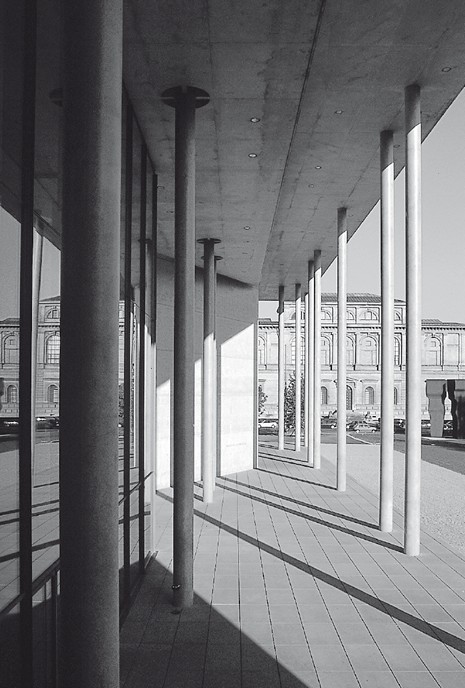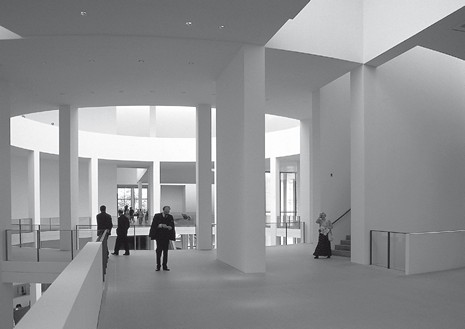Description
Two incunabula of museum architecture – the concrete presence of Klenze’s Alte Pinakothek and the central rotunda motif historically determined by Schinkel’s Altes Museum – characterize the basic structure of Munich’s third Pinakothek in different ways. Braunfels shifts his own building – which houses four heterogenous collections – so close to the edge of the site between the city centre and the two older Pinakotheks that a perspectival axis to Klenze’s museum comes into being. Its height is deliberately constrained, moreover, by partially sinking the enormous volume of the new building so that it does not rise above Klenzes’s building. The second essential motif, the diagonal running through the building, results from the anchoring of the new museum in its urban context and the opening on both sides that this requires. Lending the building, the unpretentious exterior of which has been executed in exposed concrete, its inner tension, this motif, in combination with the central rotunda, also determines the circulation and in so doing, the organisation of the various museum areas.
It is not least the structure of the building, on the whole developed on a foundational square grid – undogmatically developed at all levels, yet recognizably square – that determines the imposing funnel-form of the diagonally placed stairway, 100 metres long, rising over a height of 12 metres and linking the three main levels of the museum uninterruptedly. Below a huge domed roof light, the stairway’s two wedges meet in the rotunda (34 metres in diameter) which is also the starting point and finishing point of all other routes. The stairs integrated into the rotunda’s double skin not only reveal exciting, continuously changing perspectives, but above all, enable the spatial matrix of a variety of short cuts and combinations of tours through the almost innumerable exhibition rooms, which as large squares or double squares of different sizes are variously accessed by means of median or diagonal axes. In the rooms rigorously devoid of all technical apparatus (although they nevertheless contain concealed high calibre HVAC, security and lighting technology), whose dazzlingly white walls rise plinthless from behind sunken ventilation grilles out of the grey terrazzo floor, ingeniously combined light coming through deep, square ceiling coffers creates objectively ideal presentation conditions – a situation to which not all works of art – nor indeed all visitors – will be equal.
wettbewerbe aktuell 7/1992, pp. 27-44 • Bauwelt 22/1992, pp. 1198-1199 (Gerhard Matzig) and 22/2002, pp. 26-33 (Martina Düttmann) • Architectural Record 10/1997, p. 37 (Claudine Weber-Hof) • architektur aktuell 9/2002, pp. 80-93 (Jean Stock) • Deutsche Bauzeitschrift 7/2002, pp. 18-19 • Domus 853/2002, pp. 14-17 (Deyan Sudjic) • Museumsjournal 11/ 2002, pp. 26-29 (Corinna Lotz) • Stephan Braunfels – Pinakothek der Moderne. Art, Architecture, Design (Stephan Braunfels, Michael Mönninger, Winfried Nerdinger), Basel, 2002 • Gottfried Knapp, Stephan Braunfels. Pinakothek der Moderne München, Munich/Berlin/London/New York, 2002 • Oliver Herwig, Pinakothek der Moderne München (Die Neuen Architekturführer No. 40), Berlin 2002
Drawings
Site plan showing the containment of the Pinakothek by a slender, L-shaped volume planned as the second building phase
Lower floor
Ground floor
Third floor with rotunda gallery
Cross section, north-south
Longitudinal section, east-west
Photos

View of the Alte Pinakothek through the entrance loggia

The central rotunda, embraced by a spatial shell, is the starting and ending point of all circuits
Originally published in: Paul von Naredi-Rainer, Museum Buildings: A Design Manual, Birkhäuser, 2004.